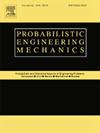A time-dependent reliability analysis method based on principal component analysis and an ensemble of surrogate models
IF 3.5
3区 工程技术
Q2 ENGINEERING, MECHANICAL
引用次数: 0
Abstract
Time-dependent reliability analysis evaluates the probability that a structural system will perform its intended function throughout its service life. However, for large-scale complex structures, particularly those with implicit performance functions, the computational cost of numerical simulation methods in time-dependent reliability analysis can be substantial. Therefore, developing an effective surrogate model for time-dependent reliability analysis can significantly reduce computational demands. To assess time-dependent reliability accurately and efficiently, a method combining principal component analysis (PCA) with an adaptive ensemble of surrogate models is proposed. In this approach, the time interval is discretized, associating instantaneous performance functions with each time node. PCA is then applied to retain a reduced set of principal components (PCs) that capture nearly all the uncertainty in the outputs. Multiple Kriging models are subsequently built based on these PCs to maximize modeling accuracy in representing the relationships between each PC and the input variables. Finally, a hybrid weighting scheme is applied to each surrogate model, balancing global and local accuracy, to compute the time-dependent failure probability of the system via weighted integration. The proposed method is validated through engineering case studies.
基于主成分分析和代理模型集成的时变可靠性分析方法
时变可靠度分析评估结构系统在其整个使用寿命内执行其预期功能的概率。然而,对于大型复杂结构,特别是那些具有隐式性能函数的结构,时变可靠性分析的数值模拟方法的计算成本可能很大。因此,开发一个有效的代理模型进行时变可靠性分析可以显著减少计算量。为了准确有效地评估时变可靠性,提出了一种将主成分分析(PCA)与自适应代理模型集成相结合的方法。在这种方法中,时间间隔是离散的,将瞬时性能函数与每个时间节点相关联。然后应用PCA来保留一组减少的主成分(pc),这些主成分捕获了输出中几乎所有的不确定性。随后,基于这些PC建立了多个克里格模型,以最大限度地提高表示每个PC与输入变量之间关系的建模精度。最后,对每个代理模型采用混合加权方案,平衡全局精度和局部精度,通过加权积分计算系统随时间变化的失效概率。通过工程实例验证了该方法的有效性。
本文章由计算机程序翻译,如有差异,请以英文原文为准。
求助全文
约1分钟内获得全文
求助全文
来源期刊

Probabilistic Engineering Mechanics
工程技术-工程:机械
CiteScore
3.80
自引率
15.40%
发文量
98
审稿时长
13.5 months
期刊介绍:
This journal provides a forum for scholarly work dealing primarily with probabilistic and statistical approaches to contemporary solid/structural and fluid mechanics problems encountered in diverse technical disciplines such as aerospace, civil, marine, mechanical, and nuclear engineering. The journal aims to maintain a healthy balance between general solution techniques and problem-specific results, encouraging a fruitful exchange of ideas among disparate engineering specialities.
 求助内容:
求助内容: 应助结果提醒方式:
应助结果提醒方式:


